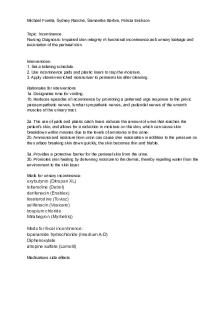Nursing Diagnosis PDF

| Title | Nursing Diagnosis |
|---|---|
| Author | Akira Allen |
| Course | Psychiatric and Mental Health Nursing |
| Institution | Mercy College |
| Pages | 5 |
| File Size | 143.3 KB |
| File Type | |
| Total Downloads | 84 |
| Total Views | 165 |
Summary
nursing diagnosis for severe anxiety...
Description
NURSING DIAGNOSIS Akira Allen NURS 250s – Psych and Mental Health Professor Glaubia Weaver
2
Identify 3 Highest Priority Nursing Diagnosis: #1 Nursing Diagnosis Risk for self-mutilation as evidence by history of self-harm in response to anxiety (Townsend, 2011).
#2 Nursing Diagnosis Risk for injury as evidence by extreme hyperactivity.
#3 Nursing Diagnosis Self-care deficit related to poor attention span as evidence by poor personal hygiene.
3
NURSING DIAGNOSIS #1 include stem, related to, as evidenced by: Predicted Behavioral Outcome: The patient will… Patient will establish alternative behavior in response to anxiety during admission. Nursing Strategies: 1. Provide frequent rest periods.
Evidence based Rationale for Strategies: 1. Prevents exhaustion.
Patient’s Actual Responses (Evaluation): 1. The patient has admitted to feeling well rested.
2. Maintain low level of stimuli in client’s environment
2. Minimizes escalation of anxiety.
2. The patient has remained free of stress in environments free of stimulation but has become anxious during meals and groups
3. Redirect violent behavior.
3. Physical exercise can decrease tension and provide focus.
3. Patient utilizes mediation techniques and guided imagery when starting to feel anxious.
4.
4.
4.
5.
5.
5.
6.
6.
6.
7.
7.
7.
Evaluation: The patient has remained calm during hospitalizations and has complied to medication treatment. The patient shows improvement in coping skills and represents with a decrease in her anxious behaviors.
4
NURSING DIAGNOSIS #2 include stem, related to, as evidenced by:
Predicted Behavioral Outcome The patient will… Patient will remain free of falls and abrasions during hospitalization. Nursing Strategies: 1. Provide structure with the help from a nurse or mental health worker
Evidence based Rationale for Strategies: 1. Structure provides focus and security (Varcarolis, 2016).
Patient’s Actual Responses (Evaluation): 1. The patient has remained focus on her care and has participated in the activities without disruption
2.
Protect client from giving away money and possessions.
2.
“Generosity” is a manic defense that is consistent with irrational, grandiose thinking.
2.
Patient asked that valuables be given to parents during her admission.
3.
Provide an environment for task efforts that is as free of distractions as possible.
3.
Client is highly distractible and is unable to perform in the presence of even minimal stimulation.
3.
Patient was able to concentrate and complete provided task at hand.
4.
4.
4.
5.
5.
5.
6.
6.
6.
7.
7.
7.
Evaluation: The patient has remained under control and has remained within normal limits of anxious behaviors. The patient has remained free of falls and injury.
5
NURSING DIAGNOSIS #3 include stem, related to, as evidenced by:
Predicted Behavioral Outcome: The patient will… Patient will maintain good hygiene daily and maintain a clean environment. Nursing Strategies: 1. Use visual cues such as a towel to prompt attention to hygiene task.
Evidence based Rationale for Strategies: 1. Visual cues can help a patient remember to perform necessary hygiene tasks.
Patient’s Actual Responses (Evaluation): 1. Patient showers and brushes teeth each morning.
2.
Identify expected level of hygiene and provide positive reinforcement for each task completed.
2.
Setting achievable expectations can help patient maintain good hygiene.
2.
Patient learns how to maintain good hygiene.
3.
Offer simple step-by-step reminders for hygiene and dress.
3.
Distractibility and poor concentration are countered by simple, concrete instructions (Varcarolis, 2016).
3.
Patient has begun bathing every other day and has dressed self in appropriate clothing.
4.
4.
4.
5.
5.
5.
6.
6.
6.
7.
7.
7.
Evaluation: Patient has reported decrease in racing thoughts and ability to somewhat focus on one task at hand. Patient showers daily and remembers to put on clean clothes when necessary.
References: Varcarolis, E. M. (2016). Foundations of psychiatric mental health nursing. Elsevier. Townsend, M. C. (2011). Nursing diagnosis in psychiatric nursing: Care plans and psychotropic medications (8th ed.). F. A. Davis....
Similar Free PDFs

Nursing diagnosis
- 2 Pages

Nursing Diagnosis
- 5 Pages

Nanda Nursing Diagnosis
- 7 Pages

Nanda Nursing Diagnosis list
- 16 Pages

Nursing diagnosis by maslows
- 9 Pages

Nursing Diagnosis FVD
- 1 Pages

Nursing Diagnosis for MIU
- 1 Pages

Nursing Diagnosis for Sepsis
- 8 Pages

Chapter 7 Nursing Diagnosis
- 1 Pages

Wizard of OZ Nursing Diagnosis
- 4 Pages
Popular Institutions
- Tinajero National High School - Annex
- Politeknik Caltex Riau
- Yokohama City University
- SGT University
- University of Al-Qadisiyah
- Divine Word College of Vigan
- Techniek College Rotterdam
- Universidade de Santiago
- Universiti Teknologi MARA Cawangan Johor Kampus Pasir Gudang
- Poltekkes Kemenkes Yogyakarta
- Baguio City National High School
- Colegio san marcos
- preparatoria uno
- Centro de Bachillerato Tecnológico Industrial y de Servicios No. 107
- Dalian Maritime University
- Quang Trung Secondary School
- Colegio Tecnológico en Informática
- Corporación Regional de Educación Superior
- Grupo CEDVA
- Dar Al Uloom University
- Centro de Estudios Preuniversitarios de la Universidad Nacional de Ingeniería
- 上智大学
- Aakash International School, Nuna Majara
- San Felipe Neri Catholic School
- Kang Chiao International School - New Taipei City
- Misamis Occidental National High School
- Institución Educativa Escuela Normal Juan Ladrilleros
- Kolehiyo ng Pantukan
- Batanes State College
- Instituto Continental
- Sekolah Menengah Kejuruan Kesehatan Kaltara (Tarakan)
- Colegio de La Inmaculada Concepcion - Cebu





